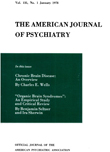ELECTROCARDIOGRAPHIC INDICES OF EMOTIONAL STRESS
Abstract
Many investigators have reported that persons under emotional stress display characteristic electrocardiographic changes. Some of these reports are reviewed to determine whether any generalizations are evident. From the published data, it appears that case and population studies overlap considerably with respect to the effects on the ECG of transient and prolonged emotional stress. In the majority of the studies, the following changes were correlated with a state of emotional tension: (1) Increased P wave amplitude; (2) depression, inversion, or distortion of the T wave; (3) ST segment deviation. These changes are associated with increased sympathetic tone, although several reports suggest that parasympathetic influences are also active(23, 10).
At least two cautions should be observed in connection with these statements which give them the status of hypotheses rather than conclusions. First, case studies tend to deal with atypical individuals, and there is little assurance that their records do not merely represent rarer but still normal ECG patterns. Second, in the population studies, the effects of the institutional regimen (diet, exercise, therapeutic procedures, etc.) are surely confounded with the emotional factors.
The experimental studies, largely because of the insufficient analyses that were performed, reveal no definite trends. However, a method for experimentally testing the hypotheses stated above should not be difficult to design. A conditioning paradigm, such as used, for example, by Schoenfeld and his associates(26, 27) and by Zeaman and Wegner (43) offers one means for doing so. In such an experimental design, the conditioned stimulus may be a light, a buzzer, etc., and the unconditioned stimulus a painful electric shock or other noxious stimulus. ECG changes may be particularly useful in comparing the course of extinction in Pavlovian and instrumental avoidance conditioning. In Pavlovian (classical) conditioning, the unconditioned stimulus invariably follows the conditioned stimulus. In avoidance conditioning, the noxious stimulus is prevented if the subject makes the appropriate response. As a result, the extinction of an avoidance response is usually a quite prolonged process, since the subject has no way of knowing that the painful stimulus no longer follows the warning signal if he continues to respond correctly. One may look upon this as a simple experimental analogue of what is generally defined as anxiety—the anticipation of pain—and conceive the reinforcement for responding to be a reduction of fear or anxiety. Indeed, such a set of experimental conditions produces anxiety so severe that even with occasional failures to respond it may require hundreds of trials—sometimes thousand—to extinguish the overt response; and, even then, the autonomic activation may still persist. It is therefore quite possible that such an approach may yield data of considerable clinical value.
Access content
To read the fulltext, please use one of the options below to sign in or purchase access.- Personal login
- Institutional Login
- Sign in via OpenAthens
- Register for access
-
Please login/register if you wish to pair your device and check access availability.
Not a subscriber?
PsychiatryOnline subscription options offer access to the DSM-5 library, books, journals, CME, and patient resources. This all-in-one virtual library provides psychiatrists and mental health professionals with key resources for diagnosis, treatment, research, and professional development.
Need more help? PsychiatryOnline Customer Service may be reached by emailing [email protected] or by calling 800-368-5777 (in the U.S.) or 703-907-7322 (outside the U.S.).



